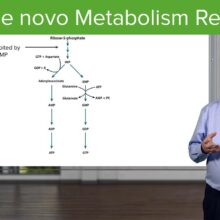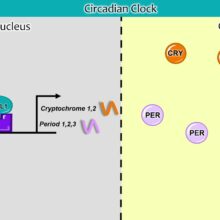Cyclins and CDKs Cell Cycle Regulation
A cell can switch from G0, or cell cycle arrest, to G1 once cells have attained a critical size. For multicellular organisms, growth factors and mitogens, which are substances encouraging cell division, need to be present. For unicellular organisms, nutrients must be adequate in surroundings. Once G1 is initiated, Cyclin D is synthesized and drives the G1/S phase transition.
In eukaryotes, Cyclin D binds with CDK 4 and CDK 6. These two complexes can partially phosphorylate retinoblastoma tumour suppressor protein, or Rb for short. Rb is bound to E2F, a transcription factor. When the CD-CDK4 and CD-CDK6 complexes partially phosphorylate Rb, it loosens its grip on E2F. E2F can then activate transcription of the cyclin E gene. Cyclin E binds CDK2, and this complex fully phosphorylates Rb, completing its inactivation.
Cyclin E also phosphorylates p27Kip1, an inhibitor of Cyclin D. Phosphorylation of p27Kip1 tags it for degradation. Degradation of this protein promotes expression of cyclin A. E2F also promotes transcription of cyclin A by removing the repressor molecule cell-cycle-responsive element (or CCRE) from the promotor, allowing the cell to enter S phase. The action of E2F on Cyclin A expression is part of a negative feedback loop, since the Cyclin A-CDK2 complex phosphorylates E2F, preventing it from removing the repressor molecule.
Cyclin A is the ONLY cyclin that plays a role in regulation of two cell cycle stages. It can activate two CDKs – CDK2 and CDK1. When Cyclin A forms a complex with CDK2, it allows the cell to progress to S phase. Meanwhile, binding of Cyclin A to CDK1 allows entry into M phase.
During S phase, Cyclin A resides in the nucleus. It directs the initiation and completion of DNA replication. Critically, Cyclin A ensures that DNA replication only occurs ONCE per cell cycle by preventing assembly of excessive replication complexes. How does it accomplish this?
Well, remember how Cyclin E is around at the end of G1? One way in which it helps the cell move into S phase is by initiating assembly of the pre-replication complex. This complex is needed for DNA replication to occur, and forms at the origin of replication. However, Cyclin A also associates with CDK2, and replaces Cyclin E. Once the Cyclin A-CDK2 complex concentration reaches a critical threshold, assembly of the pre-replication complex is terminated. The Cyclin A-CDK2 complex also regulates DNA replication by phosphorylating certain DNA replication machinery components.
Later in the S phase, Cyclin A also forms a complex with CDK1, remaining bound until late in the G2 phase, when it is replaced by cyclin B. The Cyclin A-CDK1 complex is believed to aid in activation and stabilization of the Cyclin B-CDK1 complex before being ubiquitinated. This degradation of the Cyclin A-CDK1 complex induces mitotic exit – in other words, the end of mitosis.
Cyclin B is a mitotic cyclin which binds to CDK1 to form the maturation promoting factor, or mitosis promoting factor – abbreviated MPF. The concentration of MPF rises until mitosis, until its concentration falls abruptly due to degradation of Cyclin B. High concentrations of Cyclin B are necessary for cells to enter M phase, and low concentrations are needed to exit M phase.
[ad_2]
Source link





how do lecturers expect us to memorise this bruh
Needed this to help me understand what my cdk 4/6 inhibitor is doing. Lol
I LOVE YOU
Thank you a great video 💕💕 well explained 👏👏
AWESOME! Thank you. Will definitely support you on patreon
It has a long chapter on the book but thankful that I watched this vid. I got a more simplified explanation.
I love you
Awesome
Super clear thank you so much
The theatrics made it hard for me to follow, I think it's too busy. But people learn differently, so that's okay
Thank you
Swimming in my confusing notes and decided to come here. THIS is saving my grade right now in Graduate School! THANK YOU!
Thank you so much… i am sure this can't get easier than the way you explained.. Thank you again for providing free education
Thank you very helpful!!!!!!!
Unfortunatly it was too fast to understand
I don't know but this is so simple but too much for me to understand currently as i am 16 years old😀
In our books we use slightly different names for the cyclins, (like M-cyclin, S-cyklin, G1/S-cyclin etc.) was a bit confused at the start before realizing this
excellent video thank you for your effort
Cycline E : Snaps
P27 : Mr Stark, i don't feel so good
This is one of the best videos i've ever seen, no doubt. Thanks a lot! ♥♥♥
Great video! However, don't cyclin D1 concentrations decrease during S-phase and rebound during G2?
thank you for this
Gibts das auch auf deutsch
It is people like you, oh dear creators of this video, that help us science enthusiasts to get over the complicated topics! Thank you so much 🔥🔥🔥
Isn´t P27 kip1 an inhibitor of cyclin E-CDK2, A-CDK2, ACDC2 and B-CDC2 and a stimulator for cyclin D-CDK4/6 ?
That's really so aspiring!
Thanks a zillion 😉
I feel like just listening to your video is enough, the visual aspect doesn't help, your doodles actually make understanding the content harder. Decent explanation tho.
i'll create another account so i can like this video twice
amaziiiing
Best description… It made me so clear about the concept…
Perfect for the discussion of cell cycle checkpoints and regulation. truly of great help. Thanks!
As a pharmacy student – who has a course in biology – I have to say,this is the best animated,well-explained and to the point video of explaining the subject of Cyclins and CDKs Cell Cycle Regulation ,it doesn't tire you at all and has all the necessary information for an in depth revision.I used this video when studying for my finals and it really helped.
OH MY GOOD LORD. THIS IS SO FUCKING PRECIOUS. THANKS
This is the best video that I saw since the beginning of med school love you
amazing!!!!